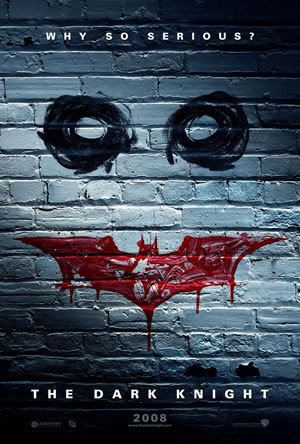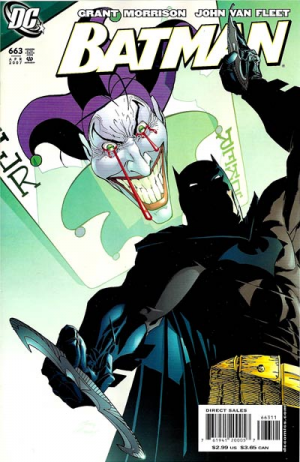On that note, I want to talk about something that interests me in two different ways. I’ve become entranced with the pre-promotional material for Batman: The Dark Knight (Chris Nolan 2008).

I have to repeat my Ghostbuster’s spiel about the level of my childhood obsession, but take it to a new and higher (and perhaps pathetic) level. I’ve been watching Batman in some form or another since I was 2 (I am now pushing 23, so this has gone on a full two decades, only a fraction of Batman’s almost seventy years of existence.) I watched the campy 60’s Adam West Batman.
And my childhood included some form of syndicated (tape-recorded?) episodes of the classic cartoon:
I watched the Dini/Timm Animated series. If you didn’t watch these, watch them, and try to catch one where Mark “Hey Kid It’s Mark Hamill” Hamill provided the voice of The Joker.
I’ve read the comic books for about as long as I could read. (This is the cover to one of my favorite Batman issues ever by one of my favorite authors ever: Grant Morrison.)

I’ve seen Tim Burton’s Batmans, which are good, but could be better, and totally not the focus of this article. I’ve seen the increasingly craptastic Joel Schumaker Batmans (HINT: Batman and Robin (Schumaker 1998) is about three times more watchable if you pretend Uma Thurman is a drag queen.) And I was a big supporter of the previous Chris Nolan-penned/directed Batman Begins which was simultaneously a popcorn flick and a pensive meditation on the nature of fear.
In short, I’m obsessed.
So, as a big fan of the previous film, and of the Batman merchandising machine in general, I was of course awaiting on baited breath for the upcoming release of The Dark Knight (which in itself seems to be referencing some of the great events in the Batman comics [The Long Halloween, The Killing Joke, and, of course, through the title Frank Miller’s classic revamp of the character.]) We got our teasers, starting with the viral “Why So Serious?” campaign. IESB.net showed a series of clips from the film. Somebody illegally posted the first five minutes on the internet. I do not recommend you watch that. Especially since it’s so easy to accidentally hit “The Dark Knight First 5 Minutes” on your search engine of choice and find it hosted on some site or another.
Filmmakers for big budget releases more and more try their best to keep, but the media hyping the release leaks bits and pieces (and the commercials do the same) until you have a feeling you have watched a sizeable portion of the film. This is what’s interesting to me on a critical or theoretical level.
Not to seem like I’m breaking things down to way too simple a level, but: people consume media. The individual members of an audience are given pieces of information. They do what they will this information, typically they try to figure out what they are seeing and try to anticipate what will happen next. So given Fact A, we then expect Fact B to arise from it. Good storytellers will either anticipate this and surprise you (giving you Fact C, for example, instead of B,) or just give you what you expect with something else (you got your B, but D is there too, or Q, or whatever.) Narrative does not exist in those frames flashing by on its own, or even in the script, or in the performances. It is in the audience constructing a narrative out of the information provided.
This might seem to take a lot of power out of the writer, director, actors, and other talent making a movie (or any other sort of art.) In fact, the opposite is true. Even though the audience really creates the story, it is up to those people to make the information received to create the most likely narrative to be created.
My real point here is that audiences might not do what is expected with these facts. Joel Schumaker might not want me turning Batman and Robin to its logical homoerotic conclusion. Or he very well might. It’s immaterial really. I could also start imagining the kind of story I would do, given the same basic information. Any viewer actively participating with the text could come to whatever conclusions they desire. This is how we in film studies end up with Marxist or Queer readings (or whatever) of a film. Not all films were originally meant with such a reading in mind.
These sorts of clips, the trailers, promotional photos, even the first five minutes as a self-contained entity, they produce narrative in miniature. They construe a story, sometimes de or recontextualize voice-overs. We try to produce a whole story, mentally, out of this incomplete information. We are given an even more limited set of facts, and begin to try to piece together a larger narrative.
The odds of us taking this incomplete handful of puzzle pieces and producing the image itself is unlikely if not downright near impossible. There are holes, gaps, what have you. But the puzzle metaphor is weak for this even though it’s visual. The best metaphor I can come up with is how they clone the dinosaurs in Jurassic Park. There were gaps in the DNA, which were filled with frog DNA. Whatever intended pattern is present in this narrative, we do not have the whole picture, and we fill in the wholes with whatever junk is around mentally. We might produce something with this information that is close to what the director had in mind, but sometimes it can. I might have the Joker leap out of the sewer like Pennywise, the clown from It. Or end the film with the climactic death scene in Batman Beyond: Return of the Joker, or add characters who are there in the comics but not in this movies’ story.
Chris Nolan has promised The Dark Knight to be a detective story, premiering Batman’s talents as one of the DC Universe’s premiere detectives. Every viewer is, in their own way, a detective. We take the information given and try to put this together into a cohesive pattern. We do this all the time, both in media, or in real life (just this week, grocery shopping, I saw somebody left a carton of cookies out of the cookie aisle on top of a pack of soda. In my own head I began producing a narrative [why the cookies were put there, the kind of person who would do this and just leave them there, &tc.]) The human mind’s ability to produce patterns is always at play, sometimes when parts of the pattern are missing. However, oftentimes it can be seen that those patterns might not be exactly what the author intended. We can arrange the raw material of the narrative, every element, into a pattern, sometimes something wildly out of what the director might have imagined (although my Batman and Robin example isn’t exactly a radical reading, all things said.)
Expect a full review after The Dark Knight comes out.
No comments:
Post a Comment